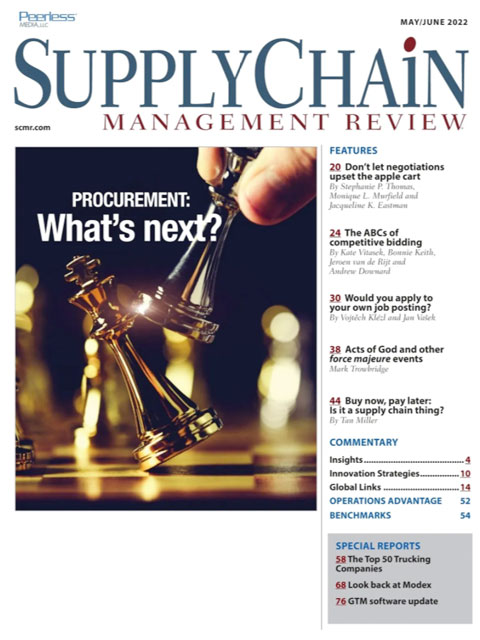Sorry, but your login has failed. Please recheck your login information and resubmit. If your subscription has expired, renew here.
May-June 2022
I recently returned from three days in Atlanta at the Modex trade show. Although advertised as a supply chain event, it’s really a materials handling automation show with a handful of logistics providers thrown in for good measure. Heading out the door to the airport, I had no idea what to expect. The two-year absence from the trade show and conference scene had me, and many of the individuals I spoke to before the show opened, wondering what’s next—not just for the show but for operations in general. If the turnout and the enthusiasm is any indication, I think supply chain is in pretty good shape these days, despite the disruptions we’ve… Browse this issue archive.Need Help? Contact customer service 847-559-7581 More options
In my last Insights column, I advised that when a portion of a supply chain becomes froth with uncertainties, it’s best to sever that portion and let supply-demand operational planning for it be handled by an ad hoc quick response (QR) team, one that is adept at making decisions under uncertainty vis a vis under risk2. Why did I believe so? Basically, because the probabilities of uncertain futures are inestimable. Hence, one can’t use traditional decision making (DM) under risk methods that are predicated upon assuming a stable probability distribution exists.
Instead, one has to apply the “muddling through” approach. That is, “managing to do something although you are not organized, and do not know how to do it.” Intractable problems can only be solved by muddling through until sufficient data is gleaned to develop proven, data-based ways to improve the situation. Executives in uncertain environments must make fast high-risk decisions as they muddle through, while basing them on negligible information and simple, practical decision-supporting models.
Winning during the pandemic
As a retiree on the sidelines, I observe global supply chains from afar. Most of my recent columns have dealt with identifying what companies have been doing during the pandemic. I’ve focused on those companies that appear to be outpacing their competitors as well as those that are losing business because of it. I’m especially concerned that global supply chains are currently being blamed for hampering the growth of worldwide economies. Based on what I’ve observed along with my years of experience, I’ve been offering advice on how to forecast and plan under risk and uncertainty, especially uncertainty.
Early in the pandemic, the losers were those whose supply chains faltered because they had never been tested by a global crisis. For instance, the pandemic exposed serious shortcomings in two extremely important U.S. supply chains: food and personal protection equipment (PPE).
There were also winners that stayed the course and beefed up their existing supply chains to succeed. In a previous column4 I discussed COVID-19’s profound impact on the overall retail market. Essentially, the strongest e-tailers got stronger on their prowess, and the weak got weaker.

This complete article is available to subscribers only.
Log in now for full access or start your PLUS+ subscription for instant access.
SC
MR
Sorry, but your login has failed. Please recheck your login information and resubmit. If your subscription has expired, renew here.
May-June 2022
I recently returned from three days in Atlanta at the Modex trade show. Although advertised as a supply chain event, it’s really a materials handling automation show with a handful of logistics providers thrown in… Browse this issue archive. Access your online digital edition. Download a PDF file of the May-June 2022 issue.In my last Insights column, I advised that when a portion of a supply chain becomes froth with uncertainties, it’s best to sever that portion and let supply-demand operational planning for it be handled by an ad hoc quick response (QR) team, one that is adept at making decisions under uncertainty vis a vis under risk2. Why did I believe so? Basically, because the probabilities of uncertain futures are inestimable. Hence, one can’t use traditional decision making (DM) under risk methods that are predicated upon assuming a stable probability distribution exists.
Instead, one has to apply the “muddling through” approach. That is, “managing to do something although you are not organized, and do not know how to do it.” Intractable problems can only be solved by muddling through until sufficient data is gleaned to develop proven, data-based ways to improve the situation. Executives in uncertain environments must make fast high-risk decisions as they muddle through, while basing them on negligible information and simple, practical decision-supporting models.
Winning during the pandemic
As a retiree on the sidelines, I observe global supply chains from afar. Most of my recent columns have dealt with identifying what companies have been doing during the pandemic. I’ve focused on those companies that appear to be outpacing their competitors as well as those that are losing business because of it. I’m especially concerned that global supply chains are currently being blamed for hampering the growth of worldwide economies. Based on what I’ve observed along with my years of experience, I’ve been offering advice on how to forecast and plan under risk and uncertainty, especially uncertainty.
Early in the pandemic, the losers were those whose supply chains faltered because they had never been tested by a global crisis. For instance, the pandemic exposed serious shortcomings in two extremely important U.S. supply chains: food and personal protection equipment (PPE).
There were also winners that stayed the course and beefed up their existing supply chains to succeed. In a previous column4 I discussed COVID-19’s profound impact on the overall retail market. Essentially, the strongest e-tailers got stronger on their prowess, and the weak got weaker.
 SUBSCRIBERS: Click here to download PDF of the full article.
SUBSCRIBERS: Click here to download PDF of the full article.
SC
MR


More Risk Management
- Israel, Ukraine aid package to increase pressure on aerospace and defense supply chains
- How CPG brands can deliver on supplier diversity promises
- How S&OP provides the answer to in-demand products
- There is still work to do to achieve supply chain stability
- Blooming success: The vital role of S&OE in nurturing global supply chains
- How one small part held up shipments of thousands of autos
- More Risk Management
Latest Resources

 Explore
Explore
Topics
Procurement & Sourcing News
- Israel, Ukraine aid package to increase pressure on aerospace and defense supply chains
- How CPG brands can deliver on supplier diversity promises
- How S&OP provides the answer to in-demand products
- There is still work to do to achieve supply chain stability
- Blooming success: The vital role of S&OE in nurturing global supply chains
- How one small part held up shipments of thousands of autos
- More Procurement & Sourcing
Latest Procurement & Sourcing Resources

Subscribe

Supply Chain Management Review delivers the best industry content.

Editors’ Picks





